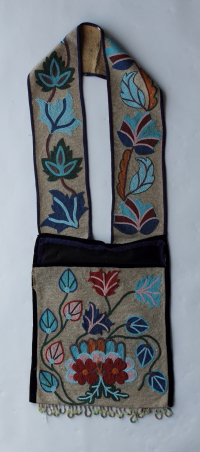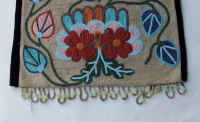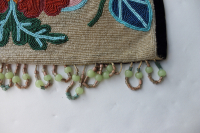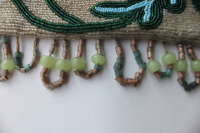Bandolier bag
Bandolier bag
Bandolier bag
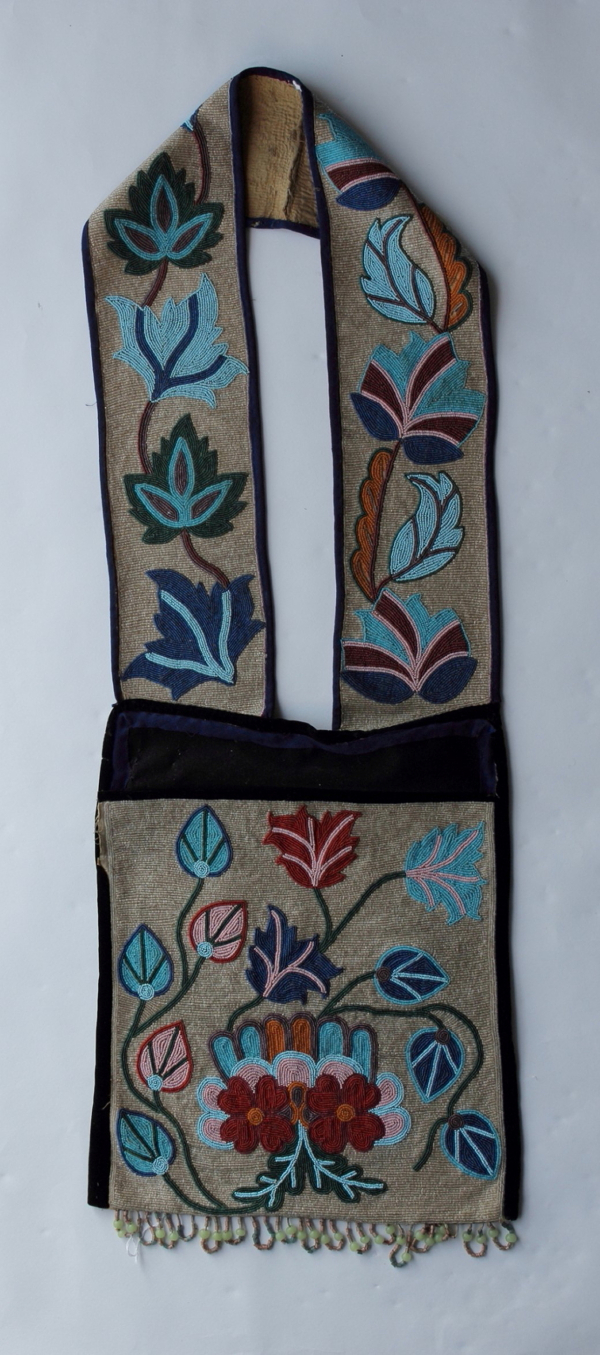


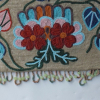

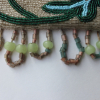
Pouch panel with two-piece shoulder strap, stroud, black velvet, overlaid spot stitch appliqué floral beading, string looped fringes
Summary of Catalogue description
Read More About This Relative
Cotton muslin, stroud, seed beads, facetted beads, twill tape, thread.
Rectangular pouch panel with two-piece shoulder strap, Front pouch panel is two layers of cotton muslin with a layer of paper in between, Back pouch panel is black stroud with purple flower patterned cloth backing, Overlaid spot stitch appliqué floral beading, Straps are two layers of cotton muslin, Pouch has a black velvet border, Strap has a two layer border of blue twill tape on top of purple cloth, Blue tape inner border around pouch top, Sewing done with black and white thread.
Beaded floral designs in a translucent, crystal background, Pouch designs have a green triple stem, Strap has a four line rust and purple coloured stem on one side and double rust coloured stem on other side, Multi-coloured opaque, semi-translucent, translucent and white core beads, Long cylindrical grey beads accent the strap, String looped fringes along bottom edge are large tube square facetted pink and green beads with large lime green round beads.
Bandolier bags most likely originated in the Upper Great Lakes region during the 1840s and 1850s. Fashioned exclusively from European materials and adorned with thousands of beads, bandolier bags were primarily for show, as a symbol of identity, wealth and status. Although initially functional, by the late 19th and early 20th centuries many of the bags had false pouches or none at all. Sometimes called "friendship bags", they were often created as gifts to strengthen relationships within communities or between nations. By the 1870s they had become an important element of formal dress worn mainly at ceremonies and celebrations by men, and occasionally by women. They wore them - singly or several at a time - crossed over the torso or draped around the neck. The wearing of more than one bag was generally the prerogative of a leader or a person of high honour. (McCord, 2013). Bandolier adopted by Ojibwa in 19th century after seeing bullet pouches used by British soldiers. Bullet pouches were plain and decorated with crest or coat of arms. When idea adopted by Ojibwa, they were greatly prized and highly decorated ceremonial accessories. They became so highly prized by Ojibwa and other tribes (especially Sioux), that one bandolier could be traded for one pony. They became a status symbol of highest ranking Midewiwin priests.
From catalogue records
Provenance
On April 17, 1921, the Hudson Bay Company purchased a collection of Aboriginal and Inuit artefacts from Dr. William Anderson, of Portage la Prairie. How he originally acquired this collection is an unanswered question. It has been postulated that he may have simply purchased his collection from any one of a number of curio dealers who were circulating catalogues, of available material, in the first quarter of the 20th century. Little is known about him or his rationale for building his collection between 1897 and 1901. This artefact was donated to the Manitoba Museum as part of the Hudson's Bay Company Museum Collection in 1994.
McCord Museum, Wearing Our Identity. Montreal: The McCord Museum, 2013; Print.
Hudson's Bay Company Historical Exhibit
Hudson's Bay Company Winnipeg Fur Trade Department collected materials in preparation for 250th anniversary celebrations of the HBC in 1920. Many of these items were used in the Processions and Pow Wow at Lower Fort Garry in May, 1920. [From catalogue records]. Acquired for the HBC Museum Collection in April 1922. One of 25,000 of artefacts from the original Hudson's Bay Company Museum Collection which was donated to the Manitoba Museum by the HBC in 1994.
opened June 19, 1922, in Winnipeg in the Portage Avenue "HBC" store.
About This GRASAC Record
Manitoba Museum













Attributed to Northeast Great Lakes-Riverine Geo-cultural area.
 Knowledge Sharing Platform
Knowledge Sharing Platform

